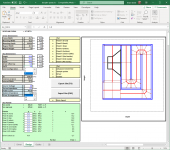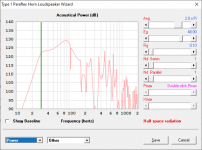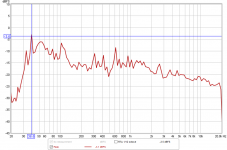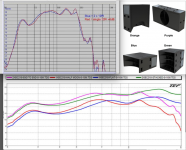And peak near 85hz, then rolling..........
Yea, bass horn, hardly a subwoofer.......
Or a horn whose mouth is too small for its length (1/4 wavelength).
If i remember a post by bill woods, low end was basically the same level with diff drivers, just goes higher if it has a lower qts.
Yea, bass horn, hardly a subwoofer.......
Or a horn whose mouth is too small for its length (1/4 wavelength).
If i remember a post by bill woods, low end was basically the same level with diff drivers, just goes higher if it has a lower qts.
The frequency response is a lot worse when you get out into the free field from 3m or so. Then it starts to look like a 'WW' bin.
I admit I am still enamored with W bins. I think the same applies to dub guys and their scoops. W bins were my first exposure to loud PA rigs. As a drummer, it was really cool to hear my kick drum interact with a system like that. That said, they just don't compete with modern subs nowadays especially as a road rig and like was said outdoors. I think the concept has its place but as mid bass units. Those are GOOD drivers for those tho! Normally these are loaded with old school stuff and cannot even compete but these will. Might work just fine for RNR parked in corners of a club. That said, these would easy to fry if playing dance music. Club I knew had EV 4050 with Peavey BW in them and had to get the reconed all the time and 99% sure it due to DJs and dance music.
were I not trilled with what I have, I would do a 100hz front loaded horn, b&c 12pe32 (or 2 x 8pe21, high horn mass corners) crossing at 750hz to 2' wide 2384 horn with 1.5" driver.
Just the way the air was manipulated, definitely different.
But you are right, definitely dropping below 100hz...………….
And bass horns don't link up well under 200hz either, they test like a direct radiator down at say 30hz.
Just the way the air was manipulated, definitely different.
But you are right, definitely dropping below 100hz...………….
And bass horns don't link up well under 200hz either, they test like a direct radiator down at say 30hz.
Those are GOOD drivers for those tho! Normally these are loaded with old school stuff and cannot even compete but these will. Might work just fine for RNR parked in corners of a club. That said, these would easy to fry if playing dance music.
The club used two of these huge W-Bins for bass duty, and yes it was a lot of dance music. For the most part they were driven by an iNuke 6000DSP. They we also crossed over pretty low, which basically "threw away" all the gain they provided from 60 Hz up.
I think I'm going to suggest to my brother that we revive my old "B1" design, perhaps with a few tweaks. Those should provide considerably more output below 60 Hz (particularly when you consider how the old W-Bins were actually used), in a smaller box to boot, and get down to the mid 30's, with no vent compression effects.
The Subwoofer DIY Page v1.1 - Projects : "Proof of Concept #4"
100db
subsonic below 40hz
that will make some noise
I heard djk's ppsl using kappa 15a's.
6th order or +6db @ tuning (speakers fs, or natural f9 due to qts .312 = 45hz), then basically subsonic below that.
basically 2 in parallel for 106db...……………
loud
4 boxes of 2 ppsl filled a very very large room.
especially tuned to 45hz, no risk of bottoming it out all the way up to power levels !!!!!
subsonic below 40hz
that will make some noise
I heard djk's ppsl using kappa 15a's.
6th order or +6db @ tuning (speakers fs, or natural f9 due to qts .312 = 45hz), then basically subsonic below that.
basically 2 in parallel for 106db...……………
loud
4 boxes of 2 ppsl filled a very very large room.
especially tuned to 45hz, no risk of bottoming it out all the way up to power levels !!!!!
I had a chance to review. I think I might not bother to go with a redesigned "B1", but to go with a Paraflex Type A instead. Basically same performance at bass frequencies in a smaller box, and a driver that's better protected. I'll post a comparison in another thread later today.
I totally get loud but in today's market I would think customers have come to expect 30hz "when the bass drops". I will be taking this into account in any future sub I build. The Keystone is no slouch but just shy of my goal. Interested with what you come up with. I am eyeing TH30.
Got any examples of the music that you're talking about?
I'd love to do a 30 Hz build, but the problem is that when Fb goes down, so does power handling in the passband, peak linear SPL too, and the box size gets bigger. So it becomes a balancing act of deciding if going to 30 Hz will bring extra people to the club, and if not being able to 30 Hz would cause people to leave and go to another club.
This club in question used to be the most popular club on the island for years, and it was running these two W-Bins for bass duty all that time. Ultimately it failed for a number of reasons, but I don't think failing to attract customers because of not being able to hit the lowest bass notes was one of them. In fact, the dance room section of this Club used to be known as the "Boom Boom Room"...
I've managed to come up with a 30 Hz PARA-A design for the drivers that we currently have on hand, B&C 18TBX100. Unfortunately power handling drops to 450W in-band and the boxes are pretty large - 24 cu.ft. in total. The box is also an unusual shape - 3 ft. high and 3 ft. high, and 2.5 ft. deep. Probably not going to be the easiest thing to move around....
I'd love to do a 30 Hz build, but the problem is that when Fb goes down, so does power handling in the passband, peak linear SPL too, and the box size gets bigger. So it becomes a balancing act of deciding if going to 30 Hz will bring extra people to the club, and if not being able to 30 Hz would cause people to leave and go to another club.
This club in question used to be the most popular club on the island for years, and it was running these two W-Bins for bass duty all that time. Ultimately it failed for a number of reasons, but I don't think failing to attract customers because of not being able to hit the lowest bass notes was one of them. In fact, the dance room section of this Club used to be known as the "Boom Boom Room"...
I've managed to come up with a 30 Hz PARA-A design for the drivers that we currently have on hand, B&C 18TBX100. Unfortunately power handling drops to 450W in-band and the boxes are pretty large - 24 cu.ft. in total. The box is also an unusual shape - 3 ft. high and 3 ft. high, and 2.5 ft. deep. Probably not going to be the easiest thing to move around....
Attachments
I'd have consult my daughter for tunes. She's the DJ and I'm an old rocker that likes making loud stuff. Totally agree on the tradeoff. Might be worth it to compromise. IE I came really close to going with those drivers in Keystones and recall them having more output than that design but it's a 35hz box. That said, 35hz is far as I would go and it at least gets you in the ballpark. If the room is famous enough maybe the boxes could fetch some decent dough to fund better drivers/amps.
I have on possible track that's still played here from time to time that's probably the best example of one of the few tracks normally played at the clubs here that might test the limits a little. Kes' "Savannah Gras", a soca tuned released in 2019 that still gets some airtime from time to time. The track features a tone around 39 Hz and another at 33 Hz, that's a good 7dB down from the first tone. There's also an overtone at 66 Hz that's a slightly higher level than the fundamental. On a ***really*** good system, I suppose that 33 Hz tone can make an audible difference (like in my car that can reach down into single digit bass frequencies), but I doubt any of the rigs here can really play it.
Kes - Savannah Grass (Official Music Video) | Soca 2019 - YouTube
Kes - Savannah Grass (Official Music Video) | Soca 2019 - YouTube
Attachments
Jeezo-Peezzo! Way too intense for whatever my cheap sound card and headphones can handle except at near mute settings. 🙁
If you are doing an permanent installation, consider to give a horn system "wings", which means to extend the horn's mouth. In a Club, some decades ago, we put such bin's under an elevated sitting area and extended the mouth about 1 meter / 1 yard, exponentially. They opend to the dance floor. The low down punch, compared to the same bin without this large mouth, was really impressive.
Club owners often do not take sound to serious, when building the location and tend to think "the sound idiots" have to put their stuff somewhere, after the important stuff is finished. May be the result of too many nights with powder in noses...
Same applies to the need of putting amps and stuff in a cool, vented space, not exposed to loud bass and the routing of cables to drive the whole stuff.
One guy asked me once "can't you do that wireless?"
PS corners can be used, too. Only down side, if any, the longer the mouth, the deeper you have to high cut.
Club owners often do not take sound to serious, when building the location and tend to think "the sound idiots" have to put their stuff somewhere, after the important stuff is finished. May be the result of too many nights with powder in noses...
Same applies to the need of putting amps and stuff in a cool, vented space, not exposed to loud bass and the routing of cables to drive the whole stuff.
One guy asked me once "can't you do that wireless?"
PS corners can be used, too. Only down side, if any, the longer the mouth, the deeper you have to high cut.
By the way, I do not understand this W-bin bashing that seems to be common here. At their time, used with the right (live) music, carefully integrated into the system, the results often where fantastic. The mistakes made by so called "sound engineers" was to use them too high in frequency and boost them at the bottom, where a filter should cut of what they can not deliver, because of the horn construction.
If you ignore physic's, you are no technician.
If you ignore physic's, you are no technician.
Great use of low end on that tune. Not usually the case. Been mulling it over. From a practical perspective since you have to use the existing drivers you are probably better off focusing on output over extension. Even if you meet or beat the the output of the old bins, sadly there could be horn fan boys that might say the other speakers were better.
BTW, does anyone have an equivalent Hornresp sim for this old W-Bin design? I thought I'd put one together some time ago, but I can't seem to find it...
I agree, W-bins (bass horns) can be amazing, but they take up a lot of space.
I can only channel DJK and his experience. For pa, they are just too big to lug around. I’m finally understanding the old olson page he’d link to.
1. Bass horns do not couple well. 200hz, yes, zero coupling at 25hz, I can post the 13’ long eaw k940 bass horn 1 vs 4 freq response, otherwise 1 box of dual 12” = 113db 1w/1m (wow), box 4 boxes share 12db of boost better than 1 …………….
See my post #3 for their own freq response graph, nice to see some honesty.
how this design looks ( PI )
2. On the floor is not 2pi, that would require the bass horn exiting at the middle of a concrete wall. “I and djk chatted often and came to the conclusion of a 3pi for a horn on a concrete floor.
Not 4pi (free space) and not 2pi either.
So the mouth area (ideally) is half way between 4pi and 2pi.”
3. Ideally, the length of the horn is ½ octave lower than the mouth, so for a 100hz horn, it should be ¼ wavelength of 75hz (3.75’).
4. Usually bass horns end up with a horn with way too small of a mouth, so we get big ripples in the low response.
I can only channel DJK and his experience. For pa, they are just too big to lug around. I’m finally understanding the old olson page he’d link to.
1. Bass horns do not couple well. 200hz, yes, zero coupling at 25hz, I can post the 13’ long eaw k940 bass horn 1 vs 4 freq response, otherwise 1 box of dual 12” = 113db 1w/1m (wow), box 4 boxes share 12db of boost better than 1 …………….
See my post #3 for their own freq response graph, nice to see some honesty.
how this design looks ( PI )
2. On the floor is not 2pi, that would require the bass horn exiting at the middle of a concrete wall. “I and djk chatted often and came to the conclusion of a 3pi for a horn on a concrete floor.
Not 4pi (free space) and not 2pi either.
So the mouth area (ideally) is half way between 4pi and 2pi.”
3. Ideally, the length of the horn is ½ octave lower than the mouth, so for a 100hz horn, it should be ¼ wavelength of 75hz (3.75’).
4. Usually bass horns end up with a horn with way too small of a mouth, so we get big ripples in the low response.
Last edited:
I don't have a sim but would love to see one. I have a pair of Sentry IV cabs coming... I will look and post if I find one.
I think it was Keele that wrote a paper and came up with same conclusion as you Norman. TH are a pretty good compromise. I really like my Keystone and think it will slay any BR near that size. Your link mentions a few things that resonate (int) with me. Played in a band and we had an EV MTL1 rig (not the the MTL4). Was very disappointed with it in small clubs but if we took that system in a large hall or outside it would destroy. I still do not understand the physics why. I think lots of folk do not believe in "throw" but I do.
I think it was Keele that wrote a paper and came up with same conclusion as you Norman. TH are a pretty good compromise. I really like my Keystone and think it will slay any BR near that size. Your link mentions a few things that resonate (int) with me. Played in a band and we had an EV MTL1 rig (not the the MTL4). Was very disappointed with it in small clubs but if we took that system in a large hall or outside it would destroy. I still do not understand the physics why. I think lots of folk do not believe in "throw" but I do.
Norman,1. Bass horns do not couple well. 200hz, yes, zero coupling at 25hz, I can post the 13’ long eaw k940 bass horn 1 vs 4 freq response, otherwise 1 box of dual 12” = 113db 1w/1m (wow), box 4 boxes share 12db of boost better than 1 …………….
See my post #3 for their own freq response graph, nice to see some honesty.
how this design looks ( PI )
2. On the floor is not 2pi, that would require the bass horn exiting at the middle of a concrete wall.
1) You found an EAW spec sheet with some mistakes, and have made incorrect conclusions based on it. The indicated sensitivity of the KF940 is not consistent with EAW's usual conformity to the industry standard of adding +6dB to half space LF measurements, and also seems to have a normalization error in reporting the "2x2" configuration.
Attached are measurements of a single 12Pi FLH (Front Loaded Horn) compared with two, the overall response increases almost exactly +6dB as would be predicted (+3dB for doubling power, +3dB for doubling cone area and cabinet).
Also included is the DSL BC18, an interesting FLH that uses a large frontal boundary (BC=Boundary Coupled). The BC18 can be deployed with the frontal area Again, the overall response increases around +6 dB, though the increased boundary area of the "End to End"(purple trace) and "Half Moon" (orange trace) increase output in the low end compared to the "Flat" or "Stacked" arrangement. The top end of the response is considerably more sensitive in the "Flat" or "Stacked" configurations, similar to the upper extension seen in FLH like the KF950 or other folded horns that have increased upper DI (directivity index).
2) True, though the usual practice of also placing the measurement microphone on the ground plane ends up making a +6dB increase in level below around 100 Hz.
Art
Attachments
Sam,Your link mentions a few things that resonate (int) with me. Played in a band and we had an EV MTL1 rig (not the the MTL4). Was very disappointed with it in small clubs but if we took that system in a large hall or outside it would destroy. I still do not understand the physics why. I think lots of folk do not believe in "throw" but I do.
Whether the cabinet is FLH, TH, BR, PPSL or sealed, they all drop at 6dB per doubling of distance in the far field.
You, Norman, and countless others have mistaken room response variations (nodes, anti-nodes, modes) for cabinet differences. If the room sucks, it sucks harder with a louder cabinet ;^)
Art
Last edited:
- Home
- Loudspeakers
- Subwoofers
- An old W-Bin....




